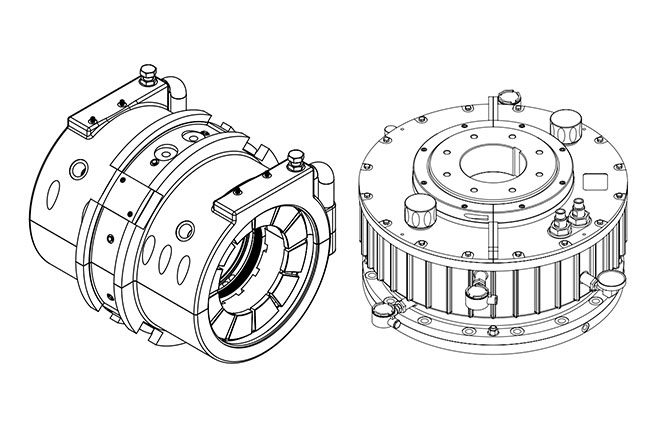Can choosing gas lubrication and gas-liquid mixed lubrication provide load-bearing capacity and stability?
Hydro&static Dynamic Slide Bearings are a common industrial device used to support and position rotating shafts. Due to its advantages of high load-bearing capacity, small friction coefficient, wear resistance, and long life, it is widely used in aerospace, shipbuilding, electric power, metallurgy, petrochemicals, engineering machinery and other fields.
There are three lubrication methods for Hydro&static Dynamic Slide Bearings: liquid lubrication, gas lubrication and gas-liquid mixed lubrication. Under high speed and large load conditions, gas lubrication and gas-liquid mixed lubrication are usually selected. This is because, compared with liquid lubrication, gas lubrication and gas-liquid mixed lubrication have higher load-bearing capacity and stability.
Gas lubrication uses the gas film formed by gas power to support the contact area between the bearing and the friction pair, thereby reducing friction and wear. Through the gap between the bearing and the shaft, compressed air is injected to form a gas film, so that the bearing is suspended on the gas film to achieve contactless operation. Gas lubrication has the advantages of low friction, low energy consumption, and no oil pollution, and is suitable for high-speed, large-load, and high-precision working conditions.
Gas-liquid mixed lubrication is based on gas lubrication. By adding liquid lubricant, it can not only provide lubrication, but also increase load-bearing capacity and stability. Gas-liquid mixed lubrication is a more comprehensive lubrication method with relatively high lubrication effect and load-bearing capacity. Under high-speed and large-load conditions, the best lubrication effect can be achieved by controlling the ratio of gas to liquid.
However, for different working conditions and requirements, it is critical to choose the appropriate lubrication method. For example, in some working conditions that require quick start and stop, gas lubrication and gas-liquid mixed lubrication have smaller inertia and can quickly adapt to work requirements. In some higher temperature working conditions, liquid lubrication can withstand higher temperatures.
For hydrostatic dynamic sliding bearings, liquid lubrication, gas lubrication and gas-liquid mixed lubrication are commonly used lubrication methods. Under high-speed and large-load conditions, choosing gas lubrication and gas-liquid mixed lubrication can provide higher load-bearing capacity and stability.
The flow of fluid plays an important role in the stability of hydrostatic dynamic sliding bearings. When the fluid flow speed inside the bearing increases, the viscosity and wettability of the fluid will weaken, thereby reducing friction and frictional heat, thereby reducing the friction loss and wear of the bearing. In this way, the stability of the bearing is improved and the service life of the bearing is extended. The following will introduce in detail the influence of fluid flow on the stability of Hydro&static Dynamic Slide Bearings and how to improve the service life of the bearings.
Fluid flow can improve bearing stability. When the fluid flow speed inside the bearing increases, a certain dynamic pressure will be formed, which will keep the sliding surface of the bearing at a certain distance. This dynamic pressure can offset the gravity of the bearing and the force exerted by the outside world, so that the bearing remains stable. In addition, fluid flow can also flush particles and impurities inside the bearing, keep the bearing clean, and reduce friction and wear of the bearing.
Fluid flow can reduce friction losses and wear of bearings. When fluid flows inside a bearing, it forms a lubricating film that reduces the contact pressure on the sliding surfaces. This lubricating film can reduce the friction and frictional heat of the bearing and avoid overheating and partial melting of the bearing. In addition, the fluid flow can also take away the friction debris generated inside the bearing, reduce the degree of wear of the bearing, and maintain the normal operation of the bearing.
The influence of fluid flow on the stability of Hydro&static Dynamic Slide Bearings also has certain limitations. When the fluid flow velocity is too high, its impact on the bearing may no longer be beneficial, and may even cause vibration and impact forces. Therefore, when designing a hydrostatic dynamic sliding bearing, it is necessary to reasonably select the flow rate of the fluid to ensure the stability and durability of the bearing.
